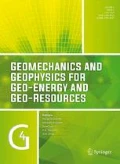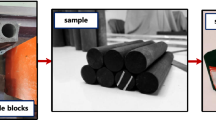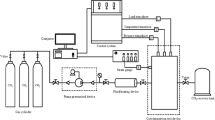Abstract
The mechanical properties and permeability of shales after supercritical carbon dioxide (SC-CO2) imbibition are vital to shale gas production and CO2 sequestration in shale reservoirs. In this study, triaxial compressive strength tests, steady state permeability tests, and CT scanning tests are performed on shale samples with 30 days of SC-CO2 imbibition. The results show that minerals dissolution and precipitation occur during SC-CO2 imbibition. The porosity calculated by the digital core increases by 19.190%. The axial stresses of samples with or without SC-CO2 imbibition increase with increasing confining pressure. When the confining pressure changes between 5 and 20 MPa, the reductions range from 6 to 13% for strength and from 11.26 to 16.47% for Young’s modulus, respectively. The strength of the samples with or without imbibition agrees well with the Mohr–Coulomb criterion. The values of cohesion and internal friction angles are very close which indicates that shale samples with SC-CO2 imbibition can still refer to the failure criterion for samples without CO2 imbibition. The permeability of the sample after SC-CO2 imbibition increases exponentially with the increase in injection pressure and decreases exponentially with an increase of effective pressure. The permeability of the sample before and after imbibition is more sensitive to the change of pore pressure than confining pressure. SC-CO2 imbibition enhances the increase of permeability. The ratio of the shale permeability after imbibition to that before imbibition varies from the minimum of 42 times to the maximum of 827 times. The reduction of strength and increasing of permeability are beneficial for shale gas recovery.










Similar content being viewed by others
References
Chen T, Feng X-T, Pan Z (2018) Experimental study on kinetic swelling of organic-rich shale in CO2, CH4 and N2. J Nat Gas Sci Eng 55:406–417
Chen T, Feng X-T, Cui G, Tan Y, Pan Z (2019) Experimental study of permeability change of organic-rich gas shales under high effective stress. J Nat Gas Sci Eng 64:1–14
Fang Y, Wang C, Elsworth D, Ishibashi T (2017) Seismicity-permeability coupling in the behavior of gas shales, CO2 storage and deep geothermal energy. Geomech Geophys Geo-Energ Geo-Resour 3(2):189–198
Farquhar S, Pearce J, Dawson G, Golab A, Sommacal S, Kirste D, Biddle D, Golding S (2015) A fresh approach to investigating CO2 storage: experimental CO2-water-rock interactions in a low-salinity reservoir system. Chem Geol 399:98–122
Feng G, Kang Y, Sun Z-D, Wang X-C, Hu Y-Q (2019) Effects of supercritical CO2 adsorption on the mechanical characteristics and failure mechanisms of shale. Energy 173:870–882
Fisher MK, Wright CA, Davidson BM, Goodwin A, Fielder E, Buckler W, Steinsberger N (2002) Integrating fracture mapping technologies to optimize stimulations in the Barnett Shale. SPE Annual Technical Conference and Exhibition, Society of Petroleum Engineers
Gaus I (2010) Role and impact of CO2–rock interactions during CO2 storage in sedimentary rocks. Int J Greenh Gas Control 4(1):73–89
Heller R, Zoback M (2014) Adsorption of methane and carbon dioxide on gas shale and pure mineral samples. J Unconvent Oil Gas Resour 8:14–24
Heller R, Vermylen J, Zoback M (2014) Experimental investigation of matrix permeability of gas shales. AAPG Bull 98(5):975–995
Jia Y, Lu Y, Elsworth D, Fang Y, Tang J (2018) Surface characteristics and permeability enhancement of shale fractures due to water and supercritical carbon dioxide fracturing. J Petrol Sci Eng 165:284–297
Jiang Y, Luo Y, Lu Y, Qin C, Liu H (2016) Effects of supercritical CO2 treatment time, pressure, and temperature on microstructure of shale. Energy 97:173–181
Jones C, Meredith P (1998) An experimental study of elastic wave propagation an isotropy and permeability an isotropy in an illitic shale. SPE/ISRM Rock Mechanics in Petroleum Engineering. Trondheim, Norway, Society of Petroleum Engineers, 7
Kolle JJ (2000) Coiled-tubing drilling with supercritical carbon dioxide. CIM International Conference on Horizontal Well Technology, Calgary, Alberta, Canada, Society of Petroleum Engineers
Kwon O, Kronenberg AK, Gangi AF, Johnson B (2001) Permeability of Wilcox shale and its effective pressure law. J Geophys Res Solid Earth 106(B9):19339–19353
Liu Z, Shao J (2017) Strength behavior, creep failure and permeability change of a tight marble under triaxial compression. Rock Mech Rock Eng 50(3):529–541
Lu Y, Ao X, Tang J, Jia Y, Zhang X, Chen Y (2016) Swelling of shale in supercritical carbon dioxide. J Nat Gas Sci Eng 30:268–275
Luo X, Wang S, Wang Z, Jing Z, Lv M, Zhai Z, Han T (2015) Adsorption of methane, carbon dioxide and their binary mixtures on Jurassic shale from the Qaidam Basin in China. Int J Coal Geol 150–151:210–223
Lutynski M, González González MA (2016) Characteristics of carbon dioxide sorption in coal and gas shale—the effect of particle size. J Nat Gas Sci Eng 28:558–565
Lyu Q, Ranjith P, Long X, Ji B (2016) Experimental investigation of mechanical properties of black shales after CO2–water–rock interaction. Materials 9(8):663
Lyu Q, Long X, Ranjith PG, Tan J, Zhou J, Wang Z, Luo W (2018a) A laboratory study of geomechanical characteristics of black shales after sub-critical/super-critical CO2 + brine saturation. Geomech Geophys Geo-Energ Geo-Resour 4:141–156
Lyu Q, Long X, Ranjith PG, Tan J, Kang Y (2018b) Experimental investigation on the mechanical behaviours of a low-clay shale under water-based fluids. Eng Geol 233:124–138
Lyu Q, Long X, Ranjith PG, Tan J, Kang Y, Wang Z (2018c) Experimental investigation on the mechanical properties of a low-clay shale with different adsorption times in sub-/super-critical CO2. Energy 147:1288–1298
Lyu Q, Shi J, Pathegama Gamage R (2020) Effects of testing method, lithology and fluid-rock interactions on shale permeability: a review of laboratory measurements. J Nat Gas Sci Eng 78:103302
Middleton RS, Carey JW, Currier RP, Hyman JD, Kang Q, Karra S, Jiménez-Martínez J, Porter ML, Viswanathan HS (2015) Shale gas and non-aqueous fracturing fluids: opportunities and challenges for supercritical CO2. Appl Energy 147:500–509
Nazari Moghaddam R, Jamiolahmady M (2016) Fluid transport in shale gas reservoirs: simultaneous effects of stress and slippage on matrix permeability. Int J Coal Geol 163:87–99
Oomole O, Osoba J (1983). Carbon dioxide-dolomite rock interaction during CO2 flooding process. Annual Technical Meeting, Petroleum Society of Canada
Pan Z, Ma Y, Connell LD, Down DI, Camilleri M (2015) Measuring anisotropic permeability using a cubic shale sample in a triaxial cell. J Nat Gas Sci Eng 26:336–344
Pan Y, Hui D, Luo P, Zhang Y, Zhang L, Sun L (2018) Influences of subcritical and supercritical CO2 treatment on the pore structure characteristics of marine and terrestrial shales. J CO2 Util 28:152–167
Rogala A, Krzysiek J, Bernaciak M, Hupka J (2013) Non-aqueous fracturing technologies for shale gas recovery. Physicochem Probl Miner Process 49:313–322
Sander R, Pan Z, Connell LD (2017) Laboratory measurement of low permeability unconventional gas reservoir rocks: a review of experimental methods. J Nat Gas Sci Eng 37:248–279
Shukla R, Ranjith PG, Choi SK, Haque A (2012) A novel testing apparatus for hydromechanical investigation of rocks: geo-sequestration of carbon dioxide. Rock Mech Rock Eng 45(6):1073–1085
Tan J, Horsfield B, Mahlstedt N, Zhang J (2015) Natural gas potential of Neoproterozoic and lower Palaeozoic marine shales in the Upper Yangtze Platform, South China: geological and organic geochemical characterization. Int Geol Rev 57(3):305–326
Toews KL, Shroll RM, Wai CM, Smart NG (1995) pH-defining equilibrium between water and supercritical CO2. Influence on SFE of organics and metal chelates. Anal Chem 67(22):4040–4043
Vengosh A, Jackson RB, Warner N, Darrah TH, Kondash A (2014) A critical review of the risks to water resources from unconventional shale gas development and hydraulic fracturing in the United States. Environ Sci Technol 48(15):8334–8348
Vesovic V, Wakeham W, Olchowy G, Sengers J, Watson J, Millat J (1990) The transport properties of carbon dioxide. J Phys Chem Ref Data 19(3):763–808
Wang H, Li G, Shen Z (2012) A feasibility analysis on shale gas exploitation with supercritical carbon dioxide. Energy Sources Part A Recov Util Environ Eff 34(15):1426–1435
Watson M (2006) Petrological characterisation of the Vlaming Sub-Basin, Perth Basin for the purpose of CO2 storage. CO2CRC Publication Number RPT06-0098
Wigand M, Carey J, Schütt H, Spangenberg E, Erzinger J (2008) Geochemical effects of CO2 sequestration in sandstones under simulated in situ conditions of deep saline aquifers. Appl Geochem 23(9):2735–2745
Yang SQ, Jing HW, Wang SY (2012) Experimental investigation on the strength, deformability, failure behavior and acoustic emission locations of red sandstone under triaxial compression. Rock Mech Rock Eng 45(4):583–606
Yin H, Zhou J, Xian X, Jiang Y, Lu Z, Tan J, Liu G (2017) Experimental study of the effects of sub-and super-critical CO2 saturation on the mechanical characteristics of organic-rich shales. Energy 132:84–95
Zhang W, Wang Q (2018) Permeability anisotropy and gas slippage of shales from the Sichuan Basin in South China. Int J Coal Geol 194:22–32
Zhang X, Lu Y, Tang J, Zhou Z, Liao Y (2017) Experimental study on fracture initiation and propagation in shale using supercritical carbon dioxide fracturing. Fuel 190:370–378
Zhang CP, Cheng P, Lu YY, Zhang DC, Zhou JP, Ma ZY (2020) Experimental evaluation of gas flow characteristics in fractured siltstone under various reservoir and injection conditions: an application to CO2-based fracturing. Geomech Geophys Geo-Energ Geo-Resour 6(1):23
Zhou J, Liu G, Jiang Y, Xian X, Liu Q, Zhang D, Tan J (2016) Supercritical carbon dioxide fracturing in shale and the coupled effects on the permeability of fractured shale: an experimental study. J Nat Gas Sci Eng 36:369–377
Zou Y, Li S, Ma X, Zhang S, Li N, Chen M (2018) Effects of CO2–brine–rock interaction on porosity/permeability and mechanical properties during supercritical-CO2 fracturing in shale reservoirs. J Nat Gas Sci Eng 49:157–168
Acknowledgements
The authors acknowledge the use of the facilities within the Monash Centre for Electron Microscopy and the financial support by Open Fund (PLC 20190802) of State Key Laboratory of Oil and Gas Reservoir Geology and Exploitation (Chengdu University of Technology), the National Natural Science Foundation of China (Grant No. 42002160) and the Natural Science Foundation of Hunan Province, China (Grant No. 2020JJ5705).
Author information
Authors and Affiliations
Corresponding author
Additional information
Publisher's Note
Springer Nature remains neutral with regard to jurisdictional claims in published maps and institutional affiliations.
Rights and permissions
About this article
Cite this article
Lyu, Q., Wang, K., Wanniarachchi, W.A.M. et al. Hydro-mechanical properties of a low-clay shale with supercritical CO2 imbibition. Geomech. Geophys. Geo-energ. Geo-resour. 6, 69 (2020). https://doi.org/10.1007/s40948-020-00200-x
Received:
Accepted:
Published:
DOI: https://doi.org/10.1007/s40948-020-00200-x




